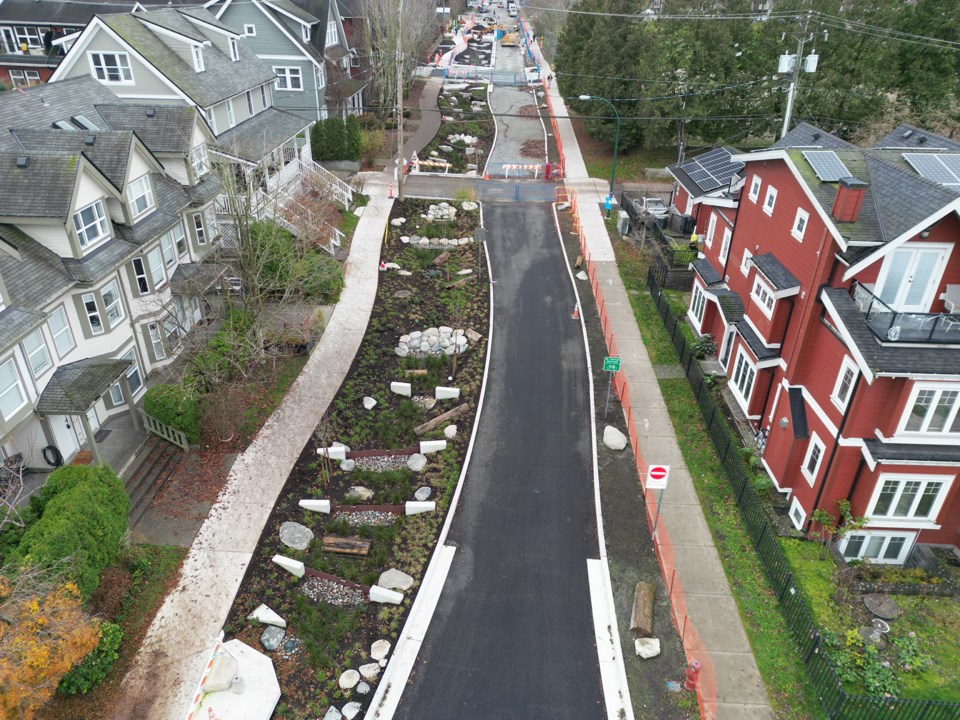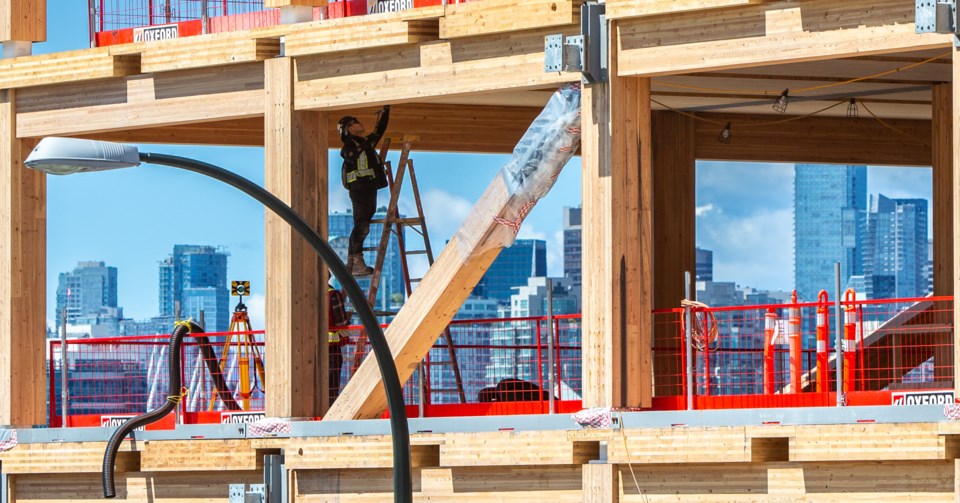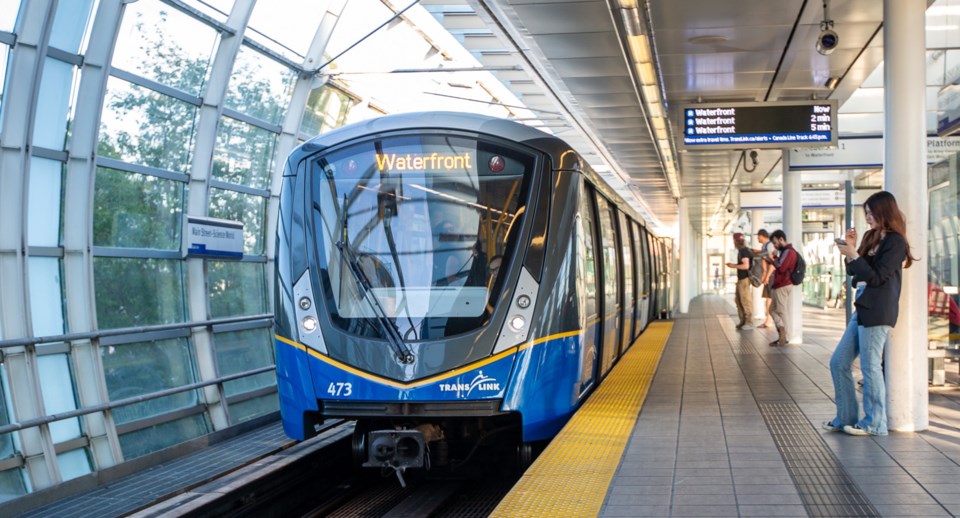The City of Vancouver has cut carbon pollution by 18 per cent since 2007 and is working towards a 50 per cent reduction by 2030, according to new data contained in staff’s annual climate change update report that goes before council July 22.
The reasons for that downward trend in emissions, which is occurring as the city’s population and economy grows, are many, as Angela Danyluk, the city’s climate adaptation and equity manager, and Matt Horne, the city’s climate mitigation manager, explained in an interview.
“In terms of what's changed since 2007, it's a lot of little things that are just sort of happening bit by bit over time,” Horne said.
“So every new building that's built now is using electric space and water heating. We're starting to see more renovations and upgrades in existing buildings. It's pretty easy to see the number of electric vehicles on our roads, and it's people, bit by bit, choosing to walk, cycle, take transit a little bit more than they did 10 or 15 years ago.”
Danyluk, who noted the recent heat and extreme rain events experienced in Vancouver, said the response from the city since 2007 has included greater use of cooling stations, the distribution of cool and clean air kits and a bylaw change to allow for cool rooms in new construction.
“We've seen a lot of change with respect to how the city prepares and responds to extreme heat events and also winter storm surge events,” she said, noting the addition of the St. George Street rainway — “a nice green linear park” — which performed really well during an atmospheric river event in October 2024.
Added Danyluk: “We invested about $1.6 million there, and a traditional grey infrastructure investment would have been $16 million. So you can see some of the benefits there, just from a cost perspective, but also a service perspective.”

'Funding gap'
Both Danyluk and Horne acknowledged the need for continuing policy change and initiatives to fight climate change and the dollars to go with it.
The 2024 “climate budget” report estimated $215 million in capital investment would be needed over 2024-26 to implement the city’s climate plan “at the levels needed to achieve our target outcomes.”
“This is broadly in line with other Canadian cities that have developed similar estimates,” said the report, noting an estimated $118 million of this funding was identified in the city’s 2023-26 capital plan.
“Opportunities to reduce the funding gap include prioritizing regulatory/advocacy tools, optimizing project delivery at a lower cost, advocating for funding from senior government and partners, and continuing to include [the climate change plan] investment needs in upcoming financial planning processes.”
In October 2021, the previous city council voted to scrap a staff recommendation to hit high-emitting, gas-powered vehicles with an annual pollution charge of up to $1,000 and roll out a citywide residential parking fee.
The “climate emergency parking program” was estimated to bring in between $44 million and $72 million by 2025.
That money would have gone towards projects such as bus priority lanes, pedestrian signals, planting more than 1,000 trees, constructing over four kilometres of green infrastructure and installing hundreds of electric vehicle charging stations.
A recommendation to implement transport pricing — charging motorists a fee when driving into the city centre — has also been shelved.

'Big moves'
In 2020, council adopted the climate emergency action plan with targets to cut carbon pollution in half by 2030, and to be carbon neutral before 2050.
At present, four of the five “big move” areas staff identified to help reduce emissions in Vancouver — such as complete and walkable neighbourhoods — are unlikely to meet targets set for 2030.
The only “big move” area staff believes will meet its target is related to accelerating the use of low carbon materials and shifting to more environment-friendly construction practices, including the use of mass timber.
The target for that “big move” is to reduce embodied emissions from new buildings and construction projects by 40 per cent compared to 2018. Developers can now construct mass timber buildings up to 18 storeys tall.
“The city continues to see new developments demonstrating leadership through approaches such as reducing underground parking and optimizing structural designs, using low carbon materials like mass timber and lower-carbon concrete,” the report said.
“Many low-/no-cost options exist today, and some of the solutions, like layout and structural design efficiency, can also reduce construction costs by using less material.”
Along with complete and walkable neighbourhoods, the other “big move” areas unlikely to meet targets are related to active transportation and transit, zero emission vehicles and zero emissions space and water heating.
City’s staff analysis of each area explains the challenges in meeting targets.
Walkable neighbourhoods
• On complete and walkable neighbourhoods and the goal to have 90 per cent of people live within an easy walk or roll of their daily needs:
Staff said significant steps in the Vancouver Plan implementation have been taken this year through advancing planning in Jericho Lands and council’s recent approval of the Rupert Renfrew Station Area Plan.
“Despite this work, achieving the 2030 target is unlikely, based on the historic and anticipated rates of development,” staff said. “Progress toward this target will impact the pace of progress toward the…active transportation and transit target.”

Cycling and walking
• On the goal of having two-thirds of trips in Vancouver to be by active transportation such as cycling and walking, along with transit:
Much of the work underway is outlined in the recently completed “active mobility plan” and council's direction on transit priority corridors and measures, as well as reallocating more space from cars to other uses.
“These investments will be supported by the removal of parking minimums in new buildings,” staff said.
“The main challenges in meeting this target are a lack of tools to disincentivize driving, along with securing the necessary investment to build out the sustainable transportation network. The financial challenges are amplified by external economic pressures.”
Zero emissions vehicles
• On the goal of 50 per cent of the kilometres driven on Vancouver’s roads to be by zero emissions vehicles:
Early uptake of electric vehicles in Vancouver continues to be “a success story,” and the provincial government's decision to strengthen the Zero Emission Vehicle Act will help continue that trend.
“The impact of tariffs on the transition to EVs is still being assessed,” staff said. “Our work is increasingly focused on ensuring there is enough home, workplace and public charging so that residents have convenient, reliable access to EV charging.”
As part of the work ahead, staff said it will look to meet charging needs through a mix of private sector, BC Hydro and city investment, including more curbside charging and more charging in city-owned parking lots.
Space and water heating
• On accelerating zero emissions space and water heating to help cut carbon pollution from buildings in half, compared to 2007:
Staff say the city has had “significant wins over the past year,” including setting higher standards for new construction, establishing time of replacement regulations for water heating in detached homes, and launching energy and emissions reporting for large office, retail and multi-family buildings.
“These changes will help transition buildings in Vancouver away from fossil fuels, but not at a pace fast enough to reach our target,” staff said.
“Further progress can be made by successfully implementing upcoming carbon pollution limits for large commercial and office buildings in 2026 and expanding to more buildings over time, introducing time of replacement heating equipment regulations in detached homes and expanding a voluntary retrofit program for multi-family buildings.”
Staff said “improving supports and removing barriers” and continued collaboration with BC Hydro are also key to making it easier and more affordable to switch to electric space and water heating in all types of buildings.
Some facts about Vancouver related to climate change:
• Carbon pollution from burning natural gas to heat buildings and hot water remains the largest portion of emissions in Vancouver. Fossil fuel use in vehicles contribute the second-biggest share of the emissions.
• With one metre of sea level rise projected by 2100, almost 13 square kilometres of city lands will be in the floodplain, meaning new risks and impacts to parklands, infrastructure, buildings and residences.
'Make a lot of positive change'
While such evidence can be overwhelming for residents, Danyluk said city staff continues to be committed to understanding how climate change is affecting people “and how we can create solutions that protect people in the best way that's possible.”
“To do that, we’re going to need the help of citizens themselves to tell us what they know and what makes them feel safe,” she said. “We're also going to need the help of our partners in provincial, federal, First Nation governments, but as well as the health authorities, private sector, the NGOs.”
Added Danyluk: “I have never been more certain about the value of taking climate action now than ever before, and there is still time to make a lot of positive change and make a lot of people's lives much better as the result of taking climate action.”






